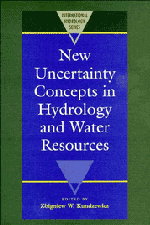Book contents
- Frontmatter
- Contents
- List of Authors
- Preface
- I INTRODUCTION
- II FACETS OF UNCERTAINTY
- III NOVEL APPROACHES TO UNCERTAINTY: FRACTALS, FUZZY SETS AND PATTERN RECOGNITION, NON-PARAMETRIC METHODS
- IV RANDOM FIELDS
- V TIME SERIES AND STOCHASTIC PROCESSES
- VI RISK, RELIABILITY AND RELATED CRITERIA
- 1 Stochastic approach to non-point pollution of surface waters
- 2 Statistically safe sets methodology for optimal management of reservoirs in risk situations
- 3 Risk assessment in control of reservoir systems
- 4 Reliability-related criteria in water supply system studies
- 5 Reliability analysis of reservoir operation
3 - Risk assessment in control of reservoir systems
Published online by Cambridge University Press: 07 May 2010
- Frontmatter
- Contents
- List of Authors
- Preface
- I INTRODUCTION
- II FACETS OF UNCERTAINTY
- III NOVEL APPROACHES TO UNCERTAINTY: FRACTALS, FUZZY SETS AND PATTERN RECOGNITION, NON-PARAMETRIC METHODS
- IV RANDOM FIELDS
- V TIME SERIES AND STOCHASTIC PROCESSES
- VI RISK, RELIABILITY AND RELATED CRITERIA
- 1 Stochastic approach to non-point pollution of surface waters
- 2 Statistically safe sets methodology for optimal management of reservoirs in risk situations
- 3 Risk assessment in control of reservoir systems
- 4 Reliability-related criteria in water supply system studies
- 5 Reliability analysis of reservoir operation
Summary
ABSTRACT Decision making in the process of control of water storage reservoirs is always combined with risk, whose evaluation is of utmost practical importance. Define the risk as the probability of failure within an operational control process, in the sense of water deficit or water surplus. The control is the sequence of interventions (releases) on future intervals. The risk is estimated on the basis of probability distributions of the total inflows within the horizon of an intervention. The stochastic process of total inflow is conceptualized as a non-stationary Markov chain of first or second order, under discrete time. The methodology is illustrated at the example of the water supply system of a cascade of reservoirs on the river Sola.
INTRODUCTION
In a real decision making problem a decision is made under the conditions of uncertainty, i.e. the decision maker does not have complete information about all elements that influence his decision.
In the water resources management the estimation of the quality of control is carried out a posteriori as a result of analysis of water management system performance within a long period of time, usually several years. A probabilistic estimation of failure in the control process is conducted through the determination of the periods of assurance of various desirable outflows. Recently some specific performance indices of water resources system, such as reliability, vulnerability, resilience and robustness have been considered (cf. Cohen, 1982; Haimes et al., 1984; Hashimoto et al., 1982a, b).
Information
- Type
- Chapter
- Information
- New Uncertainty Concepts in Hydrology and Water Resources , pp. 293 - 298Publisher: Cambridge University PressPrint publication year: 1995
